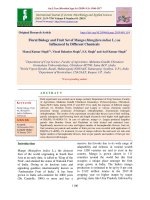Activity of soil enzyme and microorganisms in rhizosphere soil of maize (Zea mays L.) as influenced by different weed management practices
Bạn đang xem bản rút gọn của tài liệu. Xem và tải ngay bản đầy đủ của tài liệu tại đây (458.08 KB, 9 trang )
Int.J.Curr.Microbiol.App.Sci (2020) 9(7): 3611-3619
International Journal of Current Microbiology and Applied Sciences
ISSN: 2319-7706 Volume 9 Number 7 (2020)
Journal homepage:
Original Research Article
/>
Activity of Soil Enzyme and Microorganisms in Rhizosphere Soil of Maize
(Zea mays L.) as Influenced by Different Weed Management Practices
Arunkumar*, R. B. Negalur, A. S. Halepyati, G. S. Yadahalli and M. N. Nagaraj
Department of Agronomy, University of Agricultural Sciences, Raichur, College of
Agriculture, Raichur – 584 104, India
*Corresponding author
ABSTRACT
Keywords
Maize, Atrazine,
Tembotrione,
Topramezone,
Dehydogenase,
Phosphatase and
Halosulfuron
Article Info
Accepted:
22 June 2020
Available Online:
10 July 2020
A field experiment was conducted during kharif, 2017 at the Main Agricultural Research
Station, agriculture college farm, Raichur to study the “Activity of soil enzyme and
microorganisms in rhizosphere soil of maize (Zea mays L.) as influenced by different weed
management practices”. The experiment was laid out in Randomized Complete Block
Design with three replications and twelve treatments. It was evident that before sowing,
the soil enzyme activity was on par in all the treatments. At flowering and at harvest,
dehydogenase and phosphatase activity in soil differed significantly by different weed
management practices. Hand weeding twice and weedy check recorded higher
dehydrogenase and phosphatase activity of (28.32, 19.85 μg TPF g -1 soil day-1 and 32.94,
19.05 μg PNP g-1 soil hour-1, respectively) and (28.00, 19.45 μg TPF g-1 soil day-1 and
32.60, 18.34 μg PNP g-1 soil hour-1, respectively) and were significantly superior over rest
of the treatments. Whereas, within herbicidal treatments sequential application of atrazine
50 % WP @ 500 g a.i. ha-1 (PRE) at 0-3 DAS fb tembotrione 34.4 % SC @ 125 g a.i. ha -1
(POE) at 30 DAS recorded significantly higher dehydrogenase and phosphatase activity
(27.64, 19.15 μg TPF g-1 soil day-1 and 32.25, 18.14 μg PNP g-1 soil hour-1, respectively) in
soil and it was found to be on par with application of atrazine 50 % WP @ 500 g a.i. ha -1
(PRE) at 0-3 DAS fb topramezone 33.6 % SC @ 75 g a.i. ha-1 (POE) at 30 DAS and
atrazine 50 % WP @ 500 g a.i. ha-1 (PRE) at 0-3 DAS fb halosulfuron 75 % WDG @ 90 g
a.i. ha-1 (POE) at 30 DAS. Similar, was the trend with respect to N 2 fixers, Phosphate
solubilising microorganisms (PSM) and total bacterial population recorded.
Introduction
Among the cereals grown in India, maize is
gaining significant importance on account of
its growing demand for diversified uses,
especially as animal feed and industrial raw
material. Maize crop has multiple uses. The
kernel contains about 77 per cent starch, two
per cent sugar, nine per cent protein, two per
cent ash on water free basis. Maize oil has
higher poly unsaturated fatty acid content and
low in linoleic acid (0.7%) and contains high
level of natural flavor.
Maize crop is grown in warm weather
condition and it is grown in wide range of
3611
Int.J.Curr.Microbiol.App.Sci (2020) 9(7): 3611-3619
climatic conditions. About 85 per cent of the
total acreage under maize is grown during
monsoon, because in kharif, the optimum
temperature for maize growth is prevalent and
the crop stops growing if the night
temperature falls below 15.6º C or 60º F.
High temperature more than 40 ºC
particularly at anthesis is also not favourable
for maize. In India, maize is grown in all the
seasons i.e., kharif, rabi and summer. Of these
three seasons, nearly 90 per cent of the
production is from kharif season, 7-8 per cent
during rabi season and remaining 1-2 per cent
during summer season. Maize is a dualpurpose crop. The grain is used both for
human and livestock consumption and stover
is solely fed to the livestock. In India, its
current consumption is as poultry-pig-fish
feed (52%), human diet (24%), cattle feed
(11%) and seed and brewery industry (1%)
(Yakadri et al., 2015). It has high nutritive
value as it contains about 7.7-14.6% protein,
crude fibre (0.8-2.32%), carbohydrates (69.774.5%), fats (3.2- 7.7%) and ash (0.7-1.3%).
About 50-55% of total maize production is
used as food in developing countries (Anjum
et al., 2014).
Use of pre-emergent and post-emergent
herbicides would make the herbicidal weed
control more acceptable to farmers, which
will not change the existing agronomic
practices, but will allow for complete control
of weeds. Usage of pre-emergence herbicides
assumes greater importance in the view of
their effectiveness from initial stages and post
emergence herbicides at about 40-45 DAS
may help in avoiding the problem of weeds at
later stages. The farmers are seldom using
pre-emergent herbicides. Even though the
farmers used pre-emergent herbicides, in
many instances early weed control may not be
sufficient because the weed flourishes even
after critical period of crop-weed competition
and many times, it is difficult to control these
weeds by cultural operations due to incessant
rains. Further, they interfere in harvesting
operations. Therefore, there is a need to apply
post emergence (20–25 days after sowing)
herbicides for effective control of weeds.
Hence, the study was undertaken to know the
effect of different weed management practices
on dynamics of soil microorganisms and soil
enzyme activity.
Materials and Methods
Field experiment was carried out at New
Farm, AICRP on Weed Management, Main
Agricultural Research Station, College of
Agriculture, University of Agricultural
Sciences, Raichur,during kharif, 2017. The
soil type of experimental plot was vertisols
(medium deep blacksoil) whicht was medium
in available nitrogen (298.65 kg/ha), available
phosphorus (24.50 kg/ha) and available
potassium (225.72 kg/ha) and having a pH of
8.21. The experiment was laid out in a
Randomized Complete Block Design with 12
treatments. Hybrid NK-6240 of maize was
sown with recommended spacing of 60 x 20
cm. The dehydrogenase activity in the soil
samples was determined by following the
procedure as described by Casida et al.,
(1964). Ten gram of soil and 0.2 g CaCO3
were thoroughly mixed and dispensed in the
conical flasks. Each flask was added with 1.0
ml of 1.5 per cent, 2, 3, 5-triphenyl
tetrazolium chloride (TTC), 1.0 ml of one per
cent glucose solution and eight ml of distilled
water to leave a thin film of water above soil
layer. The flasks were stoppered with rubber
bunks and incubated at 300C for 24 hours. At
the end of incubation, the contents of the flask
were rinsed down into small beaker and slurry
was made by adding 10 ml of methanol. The
slurry was filtered through Whatman No. 42
filter paper. Repeated rinsing of soil with
methanol was continued till the filtrate ran
free of red colour. The filtrate was made up to
50 ml with methanol in volumetric flask. The
intensity of red colour was measured at 485
3612
Int.J.Curr.Microbiol.App.Sci (2020) 9(7): 3611-3619
nm against a methanol blank using
spectrometer. The results were expressed as
g of TPF formed per g of soil per day.
Phosphatase activity of soil samples was
determined by following the procedure of
Evazi and Tabatabai (1979). One gram of soil
sample was placed in a 50 ml Erlenmeyer
flask to which 0.2 ml toluene followed by 4
ml of modified universal buffer (pH 7.5) was
added. One ml of P-nitrophenol phosphate
solution made in modified universal buffer
was added to the flasks and contents of the
flasks were mixed by swirling for two
minutes. The flasks were stoppered and
incubated at 37°C for one hour. After
incubation, one ml of 0.5 M CaCl2 and four
ml of 0.5 M NaOH were added to the flask,
swirled and filtered through Whatman No. 42
filter paper.
The intensity of yellow colour developed was
measured at 420 nm against the reagent blank
using Graphicord Shimadzu UV-visible
Spectrophotometer (Model UV-240).Controls
were maintained for each soil sample and
were analyzed by following the same
procedure described above except that the
paranitro phenol phosphate solution was
added after the addition of 0.5 M CaCl2 and
0.5 M NaOH and just before filtration. The
phosphatase activity in the soil samples was
expressed as g paranitrophenol formed per
gram soil per hour. Enumeration of N2 fixer
From the collected soil samples, one g was
taken and serially diluted using sterile
distilled water up to 10-4 dilutions. One ml of
diluted sample from 10-4 dilutions was taken,
and 0.1ml of aliquot was inoculated in
petriplates containing sterilized N free
bromothymol blue medium under aseptic
conditions. The petriplates were be incubated
at 30ºC for a period of one week and
petriplates that show growth (white,
translucent, undulating, subsurface pellicles)
of N2 fixers will be selected for isolation and
all the samples were serially diluted by fifth
fold series and analysed for the N2 fixers by
Most probable number (MPN method) using
N free bromothymol blue media.
The phosphate solubilizing microorganisms
(PSM) was been isolated by dilution plating
technique on Pikovskaya’s agar medium
(Pikovskaya’s, 1948) containing tricalcium
phosphate (TCP). The plates were be
incubated at 28 ± 2 ºC for two to seven days.
Phosphate solubilizers produce clear hallo
zones around the microbial colonies on media
supplemented
with
insoluble
mineral
phosphates such as tricalcium phosphate or
hydroxyapatite. Further, the Enumeration of
total bacteria was done by sieving each soil
sample through the 1000 micromesh to
remove the bigger particles and debris and
was used for isolation of bacteria by serial
dilution agar plate technique using nutrient
agar medium. The 10-6 dilution of soil
suspension was used for isolation. The plates
were incubated for 24 h at 28 ºC. The colonies
that appeared on nutrient agar media were
enumerated and expressed in terms of cfu g-1
of soil on dry weight basis.
Results and Discussion
The major weeds noticed in the experimental
field at all the stages of observation were
Cyperus
rotundus
among
sedges,
Alternanthera
sessilis,
Commelina
benghalensis, Digera arvensis, Euphorbia
hirta, Euphorbia geniculata, Phyllanthus
fraternus, Parthenium hysterophorus and
Portulaca oleracea among broad leaf weeds,
Cynodon dactylon, Brachiaria eruciformis
and Dinebra retroflexa as grassy weeds. The
data on the effect of different herbicides on
soil dehydrogenase activity, Soil phosphatase
activity, N2 fixers, Phosphate solubilising
microoraganisms (PSM) and total bacterial
population were recorded.
3613
Int.J.Curr.Microbiol.App.Sci (2020) 9(7): 3611-3619
Table.1 Dehydrogenase and phosphatase activity in soil as influenced by different weed management practices in maize
Treatment
Dehydrogenase
(μg TPF g-1 soil day-1)
Phosphatase
(μg PNP g-1 soil hour-1)
Before
sowing
At flowering
stage
At
harvest
Before
sowing
At flowering
stage
At
harvest
T1: 2,4-D sodium salt 80 % WP @ 2000 g a.i. ha-1 at 20 DAS
6.81
22.81
15.40
8.06
27.16
14.73
T2: Atrazine 50 % WP @ 1000 g a.i. ha-1 at 20 DAS
7.04
22.04
14.70
8.17
26.54
14.20
T3: Tembotrione 34.4 % SC @ 125 g a.i. ha-1 at 20 DAS
7.15
23.77
16.27
8.40
28.48
15.77
T4: Halosulfuron 75 % WDG @ 90 g a.i. ha-1 at 20 DAS
6.68
23.15
15.65
7.93
27.52
15.15
T5: Topramezone 33.6 % SC @ 75 g a.i. ha-1 at 20 DAS
6.82
23.21
15.71
8.07
27.71
15.21
T6: Atrazine 50 % WP @ 500 g a.i. ha (PRE) at 0-3 DAS fb 2,4-D
80 % WP @ 2000 g a.i. ha-1 (POE) at 30 DAS
6.92
25.66
17.39
8.10
30.06
16.84
T7: Atrazine 50 % WP @ 500 g a.i. ha-1 (PRE) at 0-3 DAS fb
Atrazine 50 % WP @ 1000 g a.i. ha-1 (POE) at 30 DAS
6.82
24.54
16.41
8.07
29.04
15.86
T8: Atrazine 50 % WP @ 500 g a.i. ha-1 (PRE) at 0-3 DAS fb
Tembotrione 34.4 % SC @ 125 g a.i. ha-1 (POE) at 30 DAS
7.05
27.64
19.15
8.17
32.25
18.14
T9: Atrazine 50 % WP @ 500 g a.i. ha-1 (PRE) at 0-3 DAS fb
Halosulfuron 75 % WDG @ 90 g a.i. ha-1 (POE) at 30 DAS
6.49
27.07
18.53
7.74
31.57
17.73
T10: Atrazine 50 % WP @ 500 g a.i. ha-1 (PRE) at 0-3 DAS fb
Topramezone 33.6 % SC 75 g a.i. ha-1 (POE) at 30 DAS
6.76
27.11
18.97
8.00
31.61
18.17
T11:
Hand weeding twice at 25 and 50 DAS
7.28
28.32
19.85
8.48
32.94
19.05
T12:
Weedy check
7.07
28.00
19.45
8.20
32.60
18.34
S.Em. ±
0.15
0.30
0.27
0.14
0.34
0.29
C.D. (P=0.05)
NS
0.89
0.79
0.42
1.01
0.84
-1
PRE= pre-emergence POE = post emergence DAS= days after sowing
fb= followed by
WP= Wetteble powder WDG= Water dispersible granule
SC= Soluble concentrate
3614
Int.J.Curr.Microbiol.App.Sci (2020) 9(7): 3611-3619
Table.2 N2 fixers and Phosphate solubilising microorganisms (PSM) in rhizosphere soil as influenced by different weed management
practices in maize
N2 fixers (× 104 cfu g-1)
Treatment
PSM population (× 104 cfu g-1)
Before
sowing
At flowering
stage
At
harvest
Before
sowing
13.50
21.16
17.46
12.40
29.05
20.55
9.83
20.78
17.22
9.60
28.11
19.50
T3: Tembotrione 34.4 % SC @ 125 g a.i. ha at 20 DAS
12.83
24.40
20.84
11.73
37.26
26.32
T4: Halosulfuron 75 % WDG @ 90 g a.i. ha-1 at 20 DAS
12.59
23.30
19.74
11.49
35.71
25.36
T5: Topramezone 33.6 % SC @ 75 g a.i. ha-1 at 20 DAS
12.77
23.80
20.06
11.67
36.06
26.38
T6: Atrazine 50 % WP @ 500 g a.i. ha-1 (PRE) at 0-3 DAS fb 2,4-D 80
% WP @ 2000 g a.i. ha-1 (POE) at 30 DAS
12.66
27.22
23.66
11.56
39.67
28.13
T7: Atrazine 50 % WP @ 500 g a.i. ha-1 (PRE) at 0-3 DAS fb Atrazine
50 % WP @ 1000 g a.i. ha-1 (POE) at 30 DAS
10.50
26.16
22.60
9.40
38.06
27.97
T8: Atrazine 50 % WP @ 500 g a.i. ha-1 (PRE) at 0-3 DAS fb
Tembotrione 34.4 % SC @ 125 g a.i. ha-1 (POE) at 30 DAS
13.17
32.73
28.57
12.07
43.67
31.67
T9: Atrazine 50 % WP @ 500 g a.i. ha-1 (PRE) at 0-3 DAS fb
Halosulfuron 75 % WDG @ 90 g a.i. ha-1 (POE) at 30 DAS
13.67
31.28
27.72
12.33
41.97
29.95
T10: Atrazine 50 % WP @ 500 g a.i. ha-1 (PRE) at 0-3 DAS fb
Topramezone 33.6 % SC 75 g a.i. ha-1 (POE) at 30 DAS
12.53
32.33
28.31
11.43
42.11
30.41
T11:
Hand weeding twice at 25 and 50 DAS
12.81
35.70
31.78
11.71
44.37
33.17
T12:
Weedy check
10.17
34.00
29.20
9.82
43.10
32.67
0.94
0.54
0.65
0.73
0.59
0.72
NS
1.59
1.92
NS
1.73
2.12
T1: 2,4-D sodium salt 80 % WP @ 2000 g a.i. ha-1 at 20 DAS
-1
T2: Atrazine 50 % WP @ 1000 g a.i. ha at 20 DAS
-1
S.Em. ±
C.D. (P=0.05)
PRE= pre-emergence POE = post emergence DAS= days after sowing
WP= Wetteble powder WDG= Water dispersible granule
fb= followed by
SC= Soluble concentrate
3615
At flowering
At
stage
harvest
Int.J.Curr.Microbiol.App.Sci (2020) 9(7): 3611-3619
Table.3 Total bacterial population in soil as influenced by different weed management practice in maize
Total bacterial population (× 106 cfu g-1)
Treatment
-1
T1: 2,4-D sodium salt 80 % WP @ 2000 g a.i. ha at 20 DAS
-1
Before sowing
At flowering stage
At harvest
18.77
45.95
28.08
15.48
44.92
27.66
-1
18.48
49.28
33.07
-1
T4: Halosulfuron 75 % WDG @ 90 g a.i. ha at 20 DAS
18.24
47.78
32.11
T5: Topramezone 33.6 % SC @ 75 g a.i. ha-1 at 20 DAS
18.27
48.31
33.13
T6: Atrazine 50 % WP @ 500 g a.i. ha-1 (PRE) at 0-3 DAS fb 2,4-D 80
%
WP @ 2000 g a.i. ha-1 (POE) at 30 DAS
18.31
55.93
35.26
T7: Atrazine 50 % WP @ 500 g a.i. ha-1 (PRE) at 0-3 DAS fb Atrazine
50 % WP @ 1000 g a.i.ha-1 (POE) at 30 DAS
16.15
52.60
34.72
T8: Atrazine 50 % WP @ 500 g a.i. ha-1 (PRE) at 0-3 DAS fb
Tembotrione 34.4 % SC @ 125 g a.i. ha-1 (POE) at 30 DAS
18.82
59.59
39.00
T9: Atrazine 50 % WP @ 500 g a.i. ha-1 (PRE) at 0-3 DAS fb
Halosulfuron 75 % WDG @ 90 g a.i. ha-1 (POE) at 30 DAS
18.43
58.10
37.33
T10: Atrazine 50 % WP @ 500 g a.i. ha-1 (PRE) at 0-3 DAS fb
Topramezone
33.6 % SC 75 g a.i. ha-1 (POE) at 30 DAS
18.18
58.61
37.85
T11:
Hand weeding twice at 25 and 50 DAS
18.46
65.27
39.92
T12:
Weedy check
16.57
63.43
37.33
0.90
0.56
0.72
NS
C.D. (P=0.05)
PRE= pre-emergence POE = post emergence DAS= days after sowing fb= followed by
WP= Wetteble powder WDG= Water dispersible granule SC= Soluble concentrate
1.64
2.12
T2: Atrazine 50 % WP @ 1000 g a.i. ha at 20 DAS
T3: Tembotrione 34.4 % SC @ 125 g a.i. ha at 20 DAS
S.Em. ±
3616
Int.J.Curr.Microbiol.App.Sci (2020) 9(7): 3611-3619
Fig.1 Dehydrogenase (μg TPF g-1 soil day-1) and phosphatase (μg PNP g-1 soil hour-1) activity in
soil as influenced by different weed management practices in maize
Effect of different weed management
practices on soil enzyme activity in maize
In the present study, at different growth stages
of maize the enzyme activity in soil
significantly
influenced
by
different
treatments due to the use of various herbicides
(Table 1). Before sowing, the soil enzyme
activity was on par with each other in all the
treatments. At flowering and at harvest,
dehydogenase and phosphatase activity in soil
differed significantly by different weed
management practices. Among the different
treatments, hand weeding twice and weedy
check recorded higher dehydrogenase and
phosphatase activity of (28.32, 19.85 μg TPF
g-1 soil day-1 and 32.94, 19.05 μg PNP g-1 soil
hour-1, respectively) and (28.00, 19.45 μg TPF
g-1 soil day-1 and 32.60, 18.34 μg PNP g-1 soil
hour-1, respectively) and these treatments
were significantly superior over rest of the
treatments under study. Whereas, within the
herbicide treatments, sequential application of
atrazine 50 % WP @ 500 g a.i. ha-1 (PRE) at
0-3 DAS fb tembotrione 34.4 % SC @ 125 g
a.i. ha-1 (POE) at 30 DAS recorded
significantly higher dehydrogenase and
phosphatase activity (27.64, 19.15 μg TPF g-1
soil day-1 and 32.25, 18.14 μg PNP g-1 soil
hour-1, respectively) in soil and was found to
be on par with application of atrazine 50 %
WP @ 500 g a.i. ha-1 (PRE) at 0-3 DAS fb
topramezone 33.6 % SC @ 75 g a.i. ha-1
(POE) at 30 DAS (27.11, 18.97 μg TPF g-1
soil day-1 and 31.61, 18.17 μg PNP g-1 soil
hour-1, respectively) and atrazine 50 % WP @
500 g a.i. ha-1 (PRE) at 0-3 DAS fb
halosulfuron 75 % WDG @ 90 g a.i. ha-1
(POE) at 30 DAS (27.07, 18.53 μg TPF g-1
soil day-1 and 31.57, 17.73 μg PNP g-1 soil
hour-1, respectively). This might be due to the
reduced harmful effect of these applied
herbicides by microbial degradation at later
stages of crop growth. Similar results were
obtained by Shukla (1997) and Ankush et al.,
(2017). Among single herbicides usage, postemergence application of atrazine 50 % WP
@ 1000 g a.i. ha-1 at 20 DAS (22.04, 14.70 μg
TPF g-1 soil day-1 and 26.54, 14.20 μg PNP g-1
soil hour-1, respectively) and 2,4-D sodium
salt 80 % WP @ 2000 g a.i. ha-1 at 20 DAS
(22.81, 15.40 μg TPF g-1 soil day-1 and 27.16,
3617
Int.J.Curr.Microbiol.App.Sci (2020) 9(7): 3611-3619
14.73 μg PNP g-1 soil hour-1, respectively)
recorded significantly lowest dehydrogenase
and phosphatase activity in soil as compared
to rest of the treatments. The results are in
conformity with Nirmalnath et al., (2009),
Sebiomo et al., (2011), Nur Masirah et al.,
(2013) and Parvathraddi (2017).
Effect of different weed management
practices
on
microorganisms
in
rhizosphere soil of maize
Among the various weed management
treatments, the N2 fixers, PSM and total
bacterial population in rhizosphere soil at
flowering and at harvest stage differed
significantly (Table 2 and 3). Before sowing,
the soil microbial activity was on par with
each other in all the treatments. At flowering
stage, among the different treatments, hand
weeding twice recorded significantly higher
N2 fixers, PSM and total bacterial population
(35.70 × 104, 44.37 × 104 cfu g-1 and 65.27 ×
106 cfu g-1, respectively) in maize rhizosphere
soil and was found to be on par with weedy
check (34.00×104, 43.10 ×104 cfu g-1 and
63.43 × 106 cfu g-1, respectively) as compared
to rest of the treatments. Among the different
weed management treatments, sequential
application of atrazine 50 % WP @ 500 g a.i.
ha-1 (PRE) at 0-3 DAS fb tembotrione 34.4 %
SC @ 125 g a.i. ha-1 (POE) at 30 DAS
recorded significantly higher N2 fixers, PSM
and total bacterial population (32.73 × 104,
43.67 × 104 cfu g-1 and 59.59 × 106 cfu g-1,
respectively) in maize rhizosphere soil and it
was found to be on par with application of
atrazine 50 % WP @ 500 g a.i. ha-1 (PRE) at
0-3 DAS fb topramezone 33.6 % SC @ 75 g
a.i. ha-1 (POE) at 30 DAS (32.33 ×104, 42.11
× 104 cfu g-1 and 58.61 × 106 cfu g-1,
respectively) and atrazine 50 % WP @ 500 g
a.i. ha-1 (PRE) at 0-3 DAS fb halosulfuron 75
% WDG @ 90 g a.i. ha-1 (POE) at 30 DAS
(31.28 × 104, 41.97 × 104 cfu g-1and 58.10 ×
106 cfu g-1, respectively). Significantly lowest
N2 fixers, PSM and total bacterial population
in maize rhizosphere soil was recorded by
post-emergence application of atrazine 50 %
WP @ 1000 g a.i. ha-1 at 20 DAS (20.78 ×
104, 28.11 × 104 cfu g-1 and 44.92 × 106 cfu g1
, respectively) and 2,4-D sodium salt 80 %
WP @ 2000 g a.i. ha-1 at 20 DAS (21.16 ×
104, 29.05 × 104 cfu g-1 and 45.95 × 106 cfu g1
, respectively) alone as compared to rest of
the treatments. Similar was the trend with
respect to N2 fixers, PSM and total bacterial
population in maize rhizosphere soil at
harvest was noticed. It is clear that the effect
of herbicides on soil microbes is only
temporary. The adverse effects of herbicides,
if at all were gradually reduced with passage
of time and practically, there was no adverse
effect of tembotrione, topramezone and
halosulfuron herbicides on soil microbial
activities in terms of N2 fixers, PSM and
bacterial population in maize rhizosphere soil
both at flowering stage and at harvest of
maize crop. Similar results were also revealed
by Ayansina and Oso (2006).
It is concluded that among the herbicide
treatments, application of atrazine 50 % WP
@ 500 g a.i. ha-1 (PRE) at 0-3 DAS fb
tembotrione 34.4 % SC @ 125 g a.i. ha-1
(POE) at 30 DAS was found to be most
effective for controlling complex weeds and
there was no adverse effect of tembotrione,
topramezone and halosulfuron herbicides on
soil enzyme activity of dehydrogenase and
phosphatase and soil microbial activities in
terms of N2 fixers, PSM and bacterial
population in maize rhizosphere soil both at
flowering stage and at harvest of maize crop.
References
Anjum, S.A., Ehsanullah A. U., Tanveer, M.,
Qamar, R. and Khan, I., 2014,
Morphological
and
phenological
attributes of maize affected by different
tillage practices and varied sowing
3618
Int.J.Curr.Microbiol.App.Sci (2020) 9(7): 3611-3619
methods. American J. Plant Sci., 5:
1657-1664.
Ankush, K., Rana, M. C., Neelam, S. and
Rana, S. S., 2017, Effect of PostEmergence Herbicide -Tembotrione on
Yield, Soil Dehydrogenase Activity and
Its Phytotoxicity on Maize (Zea mays
L.) under Mid Hill Conditions of
Himachal Pradesh, India. Intl. J. Curr.
Microbiol. App. Sci., 6(8): 2297-2303.
Ayansina, A. D. V. and Oso, B. A., 2006,
Effect of two commonly used
herbicides on soil microflora at two
different concentrations. African J.
Biotechnol., 5 (2): 129-132.
Casida, L. E., Klein, D. A. and Santoro, T.,
1964, Soil dehydrogenase activity. Soil
Sci., 98: 371-376.
Nirmalnath, P. J., Patil, C. R., Agasimani, C.
A. and Doddagoudar, C. K., 2009, Soil
microbial activity as influenced by long
term application of herbicides. “Natn.
Symp. Weed Threat to Environment,
Biodiversity
and
Agriculture
Productivity”, August 2-3, 2009, Tamil
Nadu Agric. Univ., Coimbatore: 129.
Nur Masirah, Z., Rosli, B. M., Kamaruzaman
S., Mahbub, M and Yahya, A., 2013,
Effects of selected herbicides on soil
microbial populations in oil palm
plantation of Malaysia: A microcosm
experiment. African J. Microbiol. Res.,
7 (5): 367-374.
Parvathraddi, 2017, Evaluation of new postemergence herbicides and their
combinations in irrigated hybrid maize
(Zea mays L.). M. Sc. (Agri.) Thesis,
Univ. of Agric. Sci., Raichur,
Karnataka (India).
Sebiomo, A., Ogundero, V. W. and Bankole,
S. A., 2011, Effect of four herbicides on
microbial population, soil organic
matter and dehydrogenase activity.
African J. Biotechnol., 10 (5): 770-778.
Yakadri, M., Rani, P. L., Prakash, T.R.,
Madhavi, M. and Mahesh, N., 2015,
Weed management in zero till-maize.
Indian J. Weed Sci., 47(3): 240-245.
Shukla A. K., 1997. Effect of herbicides
butachlor, fluchloralin, 2, 4- D and
oxyfluorfen on microbial population
and enzyme activities of rice field soil.
Indian J. Eco., 24(2): 189-192.
How to cite this article:
Arunkumar, R. B. Negalur, A. S. Halepyati, G. S. Yadahalli and Nagaraj, M. N. 2020. Activity
of Soil Enzyme and Microorganisms in Rhizosphere Soil of Maize (Zea mays L.) as Influenced
by Different Weed Management Practices. Int.J.Curr.Microbiol.App.Sci. 9(07): 3611-3619.
doi: />
3619

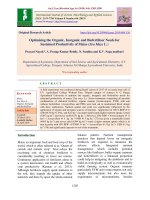
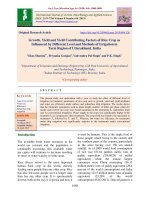
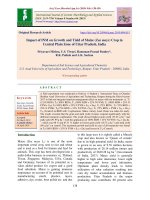
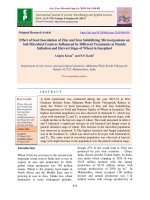
![Growth and yield of Ashwagandha [Withania somnifera (L.)] as influenced by different intercropping system in Kymore plateau of Madhya Pradesh](https://media.store123doc.com/images/document/2020_01/09/medium_vsb1578562778.jpg)



